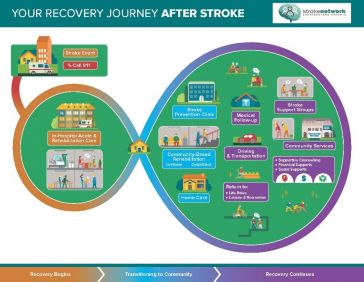 "As a stroke survivor with firsthand knowledge of some of the unique pieces of the puzzle that are needed to help us, it was deeply fulfilling to collaborate on and lend perspective to some of the tools available to assist with navigating the numerous resources out there. After a stroke, your brain is swimming around, just trying to stay afloat, and we all recognized the importance of having these tools available to ease the pressure. From the continuous nature of the Patient Journey Map to the Return to Work Toolkit and everything in between, including a check -n to get a snapshot of where you're at, our hope is that these tools may make it easier for someone to resurface and find their new baseline with dignity and purpose. Having a stroke isn't our choice, but thankfully, working hard to make it a bit easier to navigate one that has happened, IS." – Heidi Molenaar, Stroke Survivor
"As a stroke survivor with firsthand knowledge of some of the unique pieces of the puzzle that are needed to help us, it was deeply fulfilling to collaborate on and lend perspective to some of the tools available to assist with navigating the numerous resources out there. After a stroke, your brain is swimming around, just trying to stay afloat, and we all recognized the importance of having these tools available to ease the pressure. From the continuous nature of the Patient Journey Map to the Return to Work Toolkit and everything in between, including a check -n to get a snapshot of where you're at, our hope is that these tools may make it easier for someone to resurface and find their new baseline with dignity and purpose. Having a stroke isn't our choice, but thankfully, working hard to make it a bit easier to navigate one that has happened, IS." – Heidi Molenaar, Stroke Survivor
Helping stroke survivors and families navigate the complex array of available supports and services following a stroke can be a challenging but critical task for health care providers. Individual client needs evolve throughout the stroke recovery journey and it is imperative that both the stroke survivor and their family are linked to the relevant supports in a timely manner. The Stroke Network (SNSEO) has worked with their partners to develop a Navigation & Transitions tab on the SNSEO website housing navigational & transitional resources to assist health care providers in their navigation role.
As stroke survivors move through their recovery journey, they will interact with a diverse array of health care providers who will help connect them to the appropriate services. Each stroke survivor is a unique individual in a unique situation and supports must be tailored to their specific physical, cognitive, emotional, psychosocial and financial needs. This may require connections to community rehab, mental health services, vocational/employment services, social work, stroke-specific exercise programs, support groups, aphasia programs and/or a myriad of other supports. The new Navigation & Transitions tab provides a ‘toolkit’ of embedded resources/links to resources to support the health care provider including:
• Communication Guide (client FAQs and suggested responses)
• Patient Journey Map
• Patient Information Package (content listing)
• Your Stroke Journey Check-In (client self-assessment questionnaire)
• Community Stroke Rehab Program Transitions Checklist
• Regional stroke, aphasia & exercise groups
• Acute-Rehab-Community (ARC) Care Pathway
• Hospital-specific tools (e.g. KHSC Patient Oriented Discharge, BrGH Post-Stroke Patient Safety Checklist)• And lots more!!
This is an evolving resource and we are looking to you to help us grow and amend the contents of this new tab. Take a few minutes to ‘navigate’ the Navigation & Transitions tab and let us know your thoughts by contacting Shelley Huffman, shelley.huffman@kingstonhsc.ca. Together we will continue to provide best practice stroke care to clients and families in the southeast.
"You don't get told what is available, they just give you pieces of paper...you have to think of things yourself. [They] don't really explain things..." ~ Stroke Survivor


